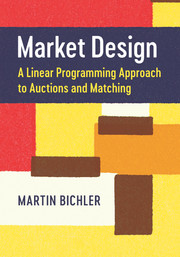Book contents
- Frontmatter
- Dedication
- Contents
- 1 Introduction
- Part I Microeconomic Fundamentals
- Part II Multi-Object Auction Design
- 5 An Overview of Multi-Object Auctions
- 6 The Simultaneous Multi-Round Auction Format
- 7 Sealed-Bid Multi-Object Auctions
- 8 Open Multi-Object Auctions
- 9 The Combinatorial Clock Auction Formats
- Part III Approximation and Matching Markets
- Part IV Appendices: Mathematical Optimization
- References
- Index
5 - An Overview of Multi-Object Auctions
from Part II - Multi-Object Auction Design
Published online by Cambridge University Press: 08 December 2017
- Frontmatter
- Dedication
- Contents
- 1 Introduction
- Part I Microeconomic Fundamentals
- Part II Multi-Object Auction Design
- 5 An Overview of Multi-Object Auctions
- 6 The Simultaneous Multi-Round Auction Format
- 7 Sealed-Bid Multi-Object Auctions
- 8 Open Multi-Object Auctions
- 9 The Combinatorial Clock Auction Formats
- Part III Approximation and Matching Markets
- Part IV Appendices: Mathematical Optimization
- References
- Index
Summary
We now focus on markets where multiple related and indivisible objects are sold. These objects might be homogeneous or heterogeneous. In general, a seller can decide to sell the objects in multiple auctions or in a single auction. Let's assume that the seller decides to sell the objects either one at a time in a sequence of single-object auctions or simultaneously; then she needs to decide on the auction format. If the seller decides to sell all objects in a single auction, there are open and sealed-bid auction designs, which we briefly introduce next. Note that we assume independent and private values of bidders and quasi-linear utility functions unless mentioned explicitly.
Since we have multiple objects, we need additional notation. Let K denote the set of objects to be auctioned (|K| = m) and k ∈ K (also l ∈ K) denote a specific object. Again, let I denote the set of bidders participating in the auction (|I| = n) and i ∈ I (also j ∈ I) denote a specific bidder.We distinguish between multi-unit auctions, where multiple identical objects are sold, and multi-item auctions, where heterogeneous objects are sold.
General Equilibrium Models
The supply and demand model of a single type of good is a partial equilibrium model where the clearance on the market of some specific good is obtained independently from prices and quantities in the markets for other goods. This makes analysis much simpler than in a general equilibrium model which includes multiple goods or objects. In partial equilibrium analysis the supply and demand for one type of good in markets with multiple buyers and sellers is analyzed in order to understand how prices arise in a competitive equilibrium. We will introduce the term competitive equilibrium more formally in definition 8.1.2. For now, such an equilibrium is a state where supply and demand are balanced and, in the absence of external influences, prices and allocation will not change.
The widespread graphical illustration of a partial equilibrium in figure 5.1 has price on the vertical axis and quantity on the horizontal axis, and it describes how competitive equilibrium prices on such markets arise and what the impact of a shift in either demand or supply implies. It provides a good initial intuition of the dynamics that can arise on exchanges.
- Type
- Chapter
- Information
- Market DesignA Linear Programming Approach to Auctions and Matching, pp. 75 - 84Publisher: Cambridge University PressPrint publication year: 2017



